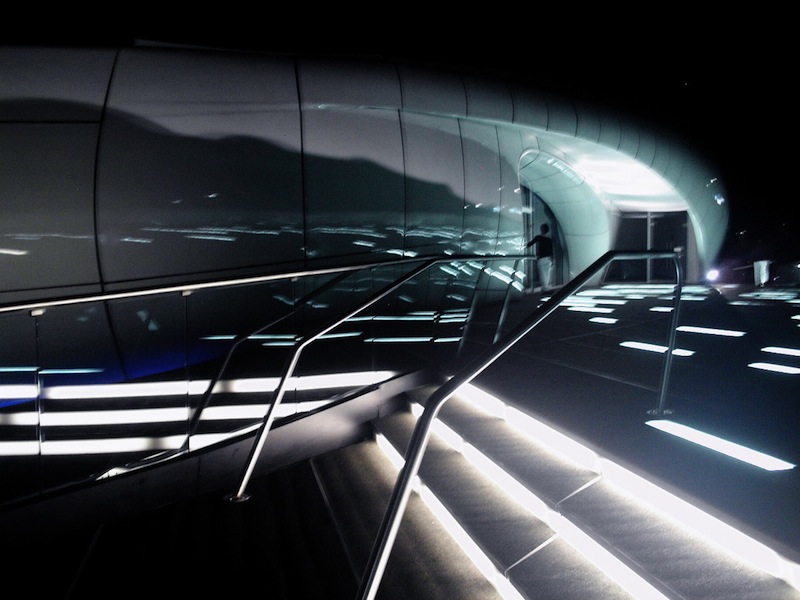Chanel: Mobile Art Pavillon
Branded Travelling Exhibition Pavilion
Inspiriert von der «Quilted Bag» von Chanel entwarf die Architektin Zaha Hadid den «Mobile Art Pavilion». Mit seiner organischen, geschwungenen Form, mehr Landschaft als architektonisches Gebäude, mutet der Pavillon an wie ein UFO. Stationen waren Hongkong (Juni 2008), Tokyo (Juli 2008) und New York (Oktober 2008), dann wurde die Weltreise , die eigentlich bis 2010 hätte dauern sollen, abgebrochen. Bis 2011 fand der Pavillon dann einen permanenten Platz vor dem Institute du Monde Arabe in Paris.
– Auftraggeber | Owner: Chanel/ Karl Lagerfeld;
– Architektur | Architecture: Zaha Hadid Architects;
– Licht | Lighting: ARUP;
– Grösse | Size: 29 x 45 m, total 700m2;
– Szenographie | Internal Scenography: Zaha Hadid Architects;
– Fertigstellung | Completion: 2008;
– Project Website: www.chanel-mobileart.com;
– YouTube Video: http://www.youtube.com/watch?gl=JP&hl=ja&v=wrrIpBmOaBM.
Chanel Mobile Art Pavilion – Concept
Source: http://www.zaha-hadid.com/built-works/chanel-mobile-art
The form of the 700 m² Chanel Pavilion is a celebration of the iconic work of Chanel, unmistakeable for its smooth layering of exquisite details that together create an elegant, cohesive whole. The resulting functional, and versatile architectural structure of the Pavilion is a series of continuous arch shaped elements, with a courtyard in its central space. Artificial light behind the translucent ceiling washes the walls to emphasize the ‘arched’ structure, and assists in the creation of a new artificial landscape for art installations. A large roof light opening dramatically floods the entrance in daylight to blur the relationship between interior and exterior. In addition to the lighting and colour effects, the spatial rhythm created by the seams of each segment gives strong perspective views throughout the interior.
The 65 m² central courtyard has large transparent openings to the sky above and is designed to host events as well as provide an area for reflection after visiting the exhibition. The courtyard serves as an intermediate space between the exhibition and public area of the Pavilion. In light of the extensive shipping between cities, the steel structure has been designed to be built in under one week, which is essential for an ephemeral pavilion. With a direct visual connection to the courtyard, the 128sqm terrace continues the dialogue between the Pavilion’s exterior and interior. During an event, the two spaces can be linked to become one large event zone.
Reflective materials allow the exterior skin to be illuminated with varying colours which can be tailored to the differing programmes of special events in each city. The dichotomy between the powerful sculptural mass of the Chanel Pavilion’s structure and the lightness of its envelope create a bold and enigmatic element. The Pavilion’s exterior develops into a rich variety of interior spaces that maximize the potential to reuse and rethink space due to the innate flexibility of its plan. The total fluidity of the Chanel Pavilion’s curvilinear geometries is an obvious continuation of Hadid’s 30-years of exploration and research into systems of continuous transformations and smooth transitions. With this repertoire of morphology, Zaha Hadid is able to translate the ephemeral typology of a pavilion into the sensual forms required for this celebration of Chanel’s cultural importance.
[flickr_set id=»72157640143894725″]
CHANEL Contemporary Art Container
Source: http://another29.exblog.jp/8190555/
CHANEL Contemporary Art Container, a traveling art space designed by Zaha Hadid Architects, has opened in its 1st destination, Hong Kong. The pavilion, commissioned by Chanel head designer Karl Lagerfeld, hosts an exhibition of artworks inspired by Chanel bags by 20 artists and called Mobile Art. The project was unveiled at the Venice art biennale last year – more details and renderings in our story on the Design Museum’s Zaha Hadid Blog.
The Mobile Art Pavilion for Chanel by Zaha Hadid Architects has been inspired by one of Chanel’s signature creations, the quilted bag. Chanel is renowned for its layering of the finest textiles and exquisite detailing to create the most elegant and cohesive pieces for each collection. In her quest for complex, dynamic and fluid spaces the work of Zaha Hadid has developed over the past thirty years through a rigorous integration of natural and human-made systems and experimentation with cutting-edge technologies.
Hadid’s architecture transforms our vision of the future with new spatial concepts and bold, visionary forms.“I think through our architecture, we can give people a glimpse of another world, and enthuse them, make them excited about ideas. Our architecture is intuitive, radical, international and dynamic. We are concerned with constructing buildings that evoke original experiences, a kind of strangeness and newness that is comparable to the experience of going to a new country. The Mobile Art Pavilion for Chanel follows these principles of inspiration,” states Zaha Hadid.
This new architecture flourishes via the new digital modelling tools that augment the design process with techniques of continuous fluidity. Zaha Hadid explains this process, “The complexity and technological advances in digital imaging software and construction techniques have made the architecture of the Mobile Art Pavilion possible. It is an architectural language of fluidity and nature, driven by new digital design and manufacturing processes which have enabled us to create the Pavilion’s totally organic forms – instead of the serial order of repetition that marks the architecture of the industrial 20th century.”
